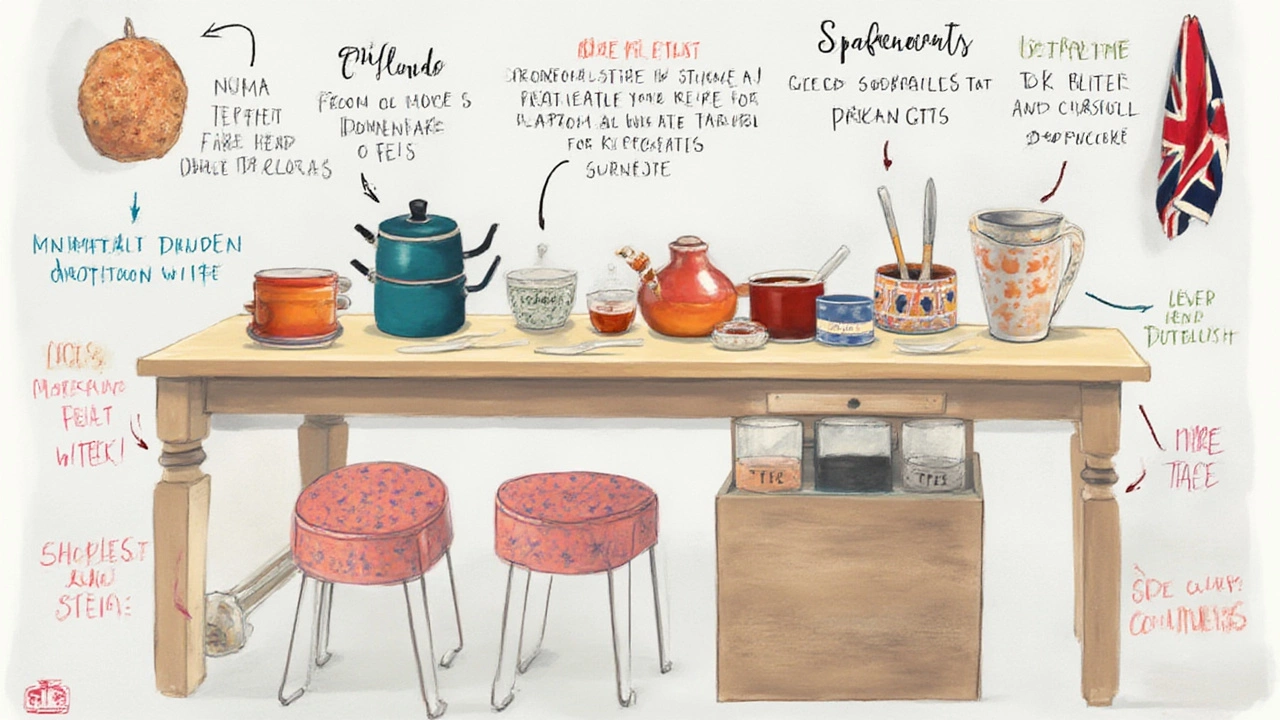Ever wonder why every home store has a section that grabs you with gleaming pans, colorful spatulas, and rows of tools you weren’t sure you needed, but now can’t imagine living without? Kitchenware sits at the crossroads of daily life and home design, with a personality all its own. Most people lump it into housewares or home decor, but there’s a real reason it deserves its own category—right up there with furniture and storage solutions. Stick around, and you’ll see how knowing what qualifies as kitchenware (and what really doesn’t) can save you money, space, and headaches next time you set up your kitchen or pick out a gift for that friend who seems to have every gadget under the sun.
Understanding Kitchenware: Definition and Boundaries
Let’s get clear on what kitchenware actually means. At its core, kitchenware includes tools, utensils, containers, and equipment for preparing, serving, or storing food. Think spatulas, mixing bowls, plates, blenders, cutting boards, knives, pots, pans, colanders, and measuring cups. The tricky part? Drawing the line between kitchenware and similar categories like appliances or tableware. For example, is a toaster kitchenware? Not really—it’s an appliance. Are wine glasses kitchenware? Kind of, but they’re more often nested under ‘tableware’ in stores. The broad consensus (among retailers, designers, and folks who care about organizing their homes) is that kitchenware sticks to the items that help you prep, cook, and serve without crossing into electrical gadgets or strictly decorative items.
If you check out stores like IKEA or Williams-Sonoma, you’ll notice that they usually split their kitchen section into utensils, cookware, bakeware, food storage, and sometimes small gadgets that aren’t powered by electricity. That’s intentional. It helps shoppers find what they need fast—no need to sort through coffee makers or decorative vases when you just need a sturdy whisk. Another way to see it: if you can use it while standing at the kitchen counter chopping, mixing, stirring, or storing food, it’s probably kitchenware.
But there’s a little overlap. Some items blur the lines by design. Take a stylish serving platter: you use it to serve, but if it’s durable, maybe you prep on it too. Bamboo cutting boards work as both a prep surface and a chic serving tray for cheese and crackers. Glass canning jars? Sure, they’re for storage, but they double as drinking glasses or flower vases (Pinterest proves it). What about ice-cream scoops? Classic kitchenware. But a vintage soda siphon—now you’re nudging into collectible territory, not daily-use kitchen essentials.
Here’s a neat trick for figuring out if something is true kitchenware: ask, would I use this in the process of making, serving, or storing food or drink? If yes, you’re staring down classic kitchenware. If the answer nudges toward decor or pure appliance, it’s in another category.
Why Kitchenware Gets Its Own Category
Why not just call it all ‘home goods’ and move on? Well, the kitchen is the hardest-working room in your home. Kitchenware handles the heavy lifting every day, from breakfast smoothies to midnight snacks. Giving it a distinct category makes it easier for everyone to find what they need without mixing up pots, pans, towels, or canisters with, say, bed linens or shower organizers.
This isn’t just about store convenience. When you move into a new place or help someone set up a first apartment, sorting out the kitchenware ensures nothing gets left behind—not a peeler or those measuring spoons you always forget until you’re halfway through a recipe. Ever tried baking and realized you have no rolling pin? That’s when you truly appreciate the difference between kitchenware and general home goods.
Retailers know this too. Walk into Target, and you’ll find clear signage dividing cookware, bakeware, gadgets, and utensils. Even popular online stores lay out categories with tabs labeled ‘Kitchenware’, ‘Appliances’, and ‘Tableware’ to avoid confusion for shoppers trying to compare nonstick pans versus casserole dishes.
There’s a psychological angle too. People bond over kitchenware. Families inherit cast iron skillets or pass down cookie cutters that are more memory than metal. One 2022 consumer study reported that nearly 70% of respondents would rather upgrade their kitchen tools than most other household items. Imagine the humble whisk or can opener beating out new bedsheets or wall art for “must-have” status. That only happens in a category with real pull in people’s everyday routines.
And here’s a tip: for wedding or housewarming gifts, stick to kitchenware basics—think good knives, mixing bowls, or storage sets. People will use them, not regift them.

Types of Kitchenware: What Belongs and What Doesn’t
If you walked into a well-organized kitchen shop, you’d be bombarded by choices. But not everything with a handle or bowl counts as kitchenware. So, what stays in the ‘kitchenware’ basket, and what gets booted out?
- Cookware: Think pots, pans, skillets, woks, and saucepans. If it goes on the stove or in the oven to cook food, it’s solidly in the kitchenware family.
- Utensils & Tools: Whisks, spatulas, ladles, tongs, zesters, garlic presses—the unsung heroes of your meal prep routine.
- Bakeware: Muffin tins, loaf pans, pie dishes, cookie sheets, bundt pans. Anything that holds dough or batter as it transforms into something delicious.
- Food Storage: Mason jars, glass containers, plastic tubs, bread boxes—if it keeps things fresh, it fits the bill.
- Prepware: Cutting boards, mixing bowls, measuring cups, colanders, and sieves.
- Servingware: Platters, salad bowls, serving spoons, gravy boats. If it delivers food from the kitchen to your table, it’s kitchenware.
But here’s what doesn’t belong:
- Large appliances: Refrigerators, dishwashers, and microwaves have their own corner—major appliances.
- Smaller electric gadgets: Blenders, mixers, or air fryers. These are small appliances, not classic kitchenware.
- Purely decorative items: That fancy fruit bowl that’s never once held a piece of fruit? Not kitchenware.
- Table-only pieces: Fine china, crystal wine glasses—usually grouped under tableware or glassware.
When you skim company websites, this division is clear. Brands like OXO, Pyrex, and Le Creuset all specialize in pieces you can grab and use instantly—no plug or battery needed.
One thing I always tell friends: don’t be fooled by gimmicks labeled as ‘essential kitchenware.’ That avocado slicer might look cute but could gather dust next to your much-used chef’s knife. Stick to the tried-and-true tools to keep clutter in check and drawers unclogged.
Smart Shopping: Choosing the Right Kitchenware for Your Needs
Now for the fun (and sometimes bewildering) part: stocking up. Knowing what’s really kitchenware is just the start. How do you choose pieces that last and don’t drain your wallet?
Start with a checklist before you shop:
- Go through a typical week—think breakfast, lunch, dinner, snacks. What tools did you use every time?
- Do a ‘pantry audit’ and mark the stuff you rarely touch. Maybe that melon baller was a splurge you never really needed.
- Pick pieces you’ll use for multiple tasks. A large mixing bowl can work for salad, bread dough, or popcorn nights. A heavy-duty pan doubles for sautéing and oven-roasting.
- Watch out for space-wasters. If your kitchen is on the small side, stick to nesting bowls, stackable containers, and multi-purpose tools (hello, microplane grater).
- Read reviews. The best kitchenware has loud fans—look for well-loved gadgets and ignore the one-hit wonders.
Quality trumps quantity. Stainless steel, cast iron, and borosilicate glass last years, sometimes decades. Cheaper plastic or novelty gadgets break just when you need them most. Plus, investing in sturdy basics helps build habits—cooking for yourself gets easier when you trust your tools won’t let you down.
Check retailer return policies, too. Many reputable brands offer guarantees on their bestsellers—a smart sign you won’t regret your picks.
For organization, separate your kitchenware by use: prep, cook, bake, serve, and store. This little hack saves time and mental energy: digging through a single drawer for a spatula versus a slotted spoon is a recipe for kitchen chaos.
One more tip: don’t underestimate kitchenware ‘starter kits’ for students, new grads, or anyone setting up a home. They usually bundle the basics for less than buying one at a time—and you skip the guesswork.

The Hidden Impact of Great Kitchenware on Home Life
Maybe you haven’t thought much about why picking the right kitchenware matters, but spend a couple of weeks with poor-quality tools and you’ll learn fast. Ever tried to flip a pancake with a flimsy plastic spatula, or mix cookie dough with a bowl that slides all over the counter? That’s when you realize how much energy, time, and even joy you save with the good stuff.
Kitchenware that’s well-designed isn’t just about cooking—it’s about making life easier. Think about that nonstick pan that lets you use less oil or that glass storage set that keeps Monday’s meal just as tasty on Friday.
Kids notice this too. Introducing children to colorful measuring spoons or sturdy child-size mixing bowls can turn baking day into a family tradition. Chefs swear by particular knives or pans because the right tool turns kitchen stress into a daily rhythm you actually look forward to.
There’s also an eco-friendly angle. Choosing reusable food containers, glass jars, metal straws, and silicone baking mats cuts down on disposable packaging. Swapping single-use items for kitchenware that lasts is one of the easiest ways to reduce your waste at home. In 2023, a Consumer Reports survey found that buyers under 35 were twice as likely as their parents to look for eco-friendly kitchenware options. So those bamboo cutting boards and beeswax wraps aren’t just trendy—they’re practical and planet-smart updates for any kitchen.
Even social lives get a boost. Hosting friends for dinner? The right serving dishes, trays, and utensils make everything run smoother. People notice when hot food stays hot and table settings look pulled together. You don’t have to splash out on full sets—sometimes just having a few quality pieces does the trick.
And finally, think about health. BPA-free storage, sharp knives (less risk of slipping!), and easy-to-clean surfaces mean less stress about germs or sketchy materials. That’s not something you always get with bargain-bin or ‘disposable’ kitchen tools.
So yes, the seemingly simple act of sorting out your kitchenware can change how you eat, entertain, and enjoy the little moments at home. Turns out, every spatula and bowl is a tiny piece of that bigger, everyday puzzle.

